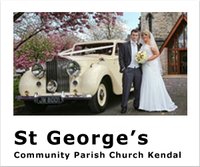


Local Sponsors
-
St George's Community Parish Church
Castle Street, Kendal, Cumbria. LA9 7AS
At St George’s Church we aim to reach out to God in worship and to each other in fellowship. We hope you will find us a friendly and inclusive church and we would be delighted to meet you at any of our services or activities. We are also part of an exciting new mission across Cumbria, in partnership with other denominations, called God for All. The aim of God for All is that by 2020 all the people of Cumbria, of all ages and backgrounds, will have had an opportunity to discover more of God and God’s purpose for their lives. You can read more about God for All and stories about local Christian people’s lives and faith by visiting our website. Please take the time to also read more about Worship and Services, Baptisms, Weddings and Funerals, Facilities for Hire, Activities, Pause for Prayer and our latest news.
-
South Cumbria Rivers Trust
The Clock Tower Business Centre Low Wood, Ulverston, Cumbria. LA12 8LY
We are a Registered Charity (no. 1114682) whose purpose is to protect, conserve and rehabilitate the aquatic environments of South Cumbria. The main rivers in our area are the Kent, Leven, Bela, Crake and Duddon as well as the many smaller rivers. We also have some significant still waters in our area including Windermere, Coniston, Grasmere, Rydal, and Esthwaite.
More information
Additionally,
Kendal's geographical situation along the banks of the River Kent renders it susceptible to flooding during periods of high river levels. The most severe flooding occurred in 1954, submerging approximately 39 acres of land surrounding the town and inundating nearly 300 houses. The floodwater reached a peak flow of 9,900 cubic feet per second. Subsequent flooding transpired in 1968, prompting the Lancashire River Authority, responsible for the river, to implement a flood defense scheme. This scheme, executed in six phases between 1972 and 1978 at a cost of £1 million, aimed to prevent town flooding from flows up to the maximum experienced in 1954.The scheme impacted a 3.5-mile stretch of the river, extending from Mintsfeet in the north to Watercrook inthe south. The flood defenses consisted of an embankment constructed on the east bank of the river, along with a control structure near Nether Bridge, which includes a sluice gate and a pumping station. These measures significantly reduced the risk of flooding in Kendal.In recent years, the church has continued to play an essential role in the community. It serves as a place of worship for Anglicans in Kendal and hosts regular services, including Sunday worship, weddings, funerals, and baptisms. The church also engages in various community outreach programs, such as hosting events, supporting local charities, and providing a space for community gatherings.Please note that the information provided here is based on the historical records up until 2021. For the most accurate and up-to-date information about St. George's Church in Kendal, it is recommended to consult official sources or contact the church directly. Kendal's geographical position along the banks of the River Kent renders it susceptible to flooding during periods of elevated river levels. The most notable occurrence transpired in 1898; however, on December 2nd, 1954, the town witnessed the highest recorded floodwater levels since that time. Approximately 39 acres (15.8 ha) of land in and around Kendal succumbed to inundation, resulting in nearly 300 houses being submerged. At its peak, the river carried a staggering 9,900 cubic feet (280 m3) of water per second. Subsequently, Kendal experienced another flood event in 1968, prompting the Lancashire River Authority, responsible for the river, to implement a flood defense scheme.Designed to withstand flows up to the maximum encountered in 1954 and prevent flooding within the town, the flood defense scheme was executed in six phases between 1972 and 1978 at a cost of £1 million. It encompassed a 3.5-mile (5.6 km) stretch of the river, extending from Mintsfeet in the north to Watercrook in the south. The scheme involved widening the river channel, specifically increasing the width of the section between Nether Bridge and Miller Bridge from 66 feet (20 m) to 125 feet (38 m). Additionally, the depth of the channel was augmented at certain points, necessitating the removal of 310 thousand cubic yards (240,000 m3) of spoil. This extracted material was repurposed in constructing the foundation of a business park situated on Kendal's southern side.The deeper channel necessitated the protection of existing river walls and bridges against erosion. To achieve this, concrete buttressing was constructed in front of the walls, which were then faced with stone. Some widened sections required the construction of new walls, while limestone blocks were employed to safeguard certain banks. Overall, the completion of the scheme entailed the installation of 1.24 miles (2 km) of buttressing and 1.05 miles (1.7 km) of new walls. Due to the river's expanded width at that point, the Jennings Yard footbridge had to be replaced. Furthermore, to prevent the river from drying out during periods of low flow, a series of low weirs were erected throughout the town. Earth embankments were also established to safeguard Mintsfeet and Helsington, with the latter location necessitating an automatic flood gate to avert floodwater breaching the defenses via the leat to Helsington Mill.During periods of high flow, the river transports substantial volumes of gravel downstream, which subsequently settles as the river slows. To prevent the accumulation of gravel in the town section, a sizable lagoon was constructed just below the confluence of the River Kent and the River Mint. This lagoon acts as a gravel trap, facilitating the periodic removal of gravel more efficiently than if it were dispersed throughout the town area. The efficacy of the new defenses was tested in 1985 when a flood of similar magnitude to that in 1954 passed through the town without breaching any of the defenses.In February 2004 and January 2005, sections of Mintsfeet experienced flooding from the river, affecting both residential and business properties on the Lake District Business Park and the Mintsfeet Industrial Estate. Flood embankments, initially built in the 1980s to protect the industrial areas from the two rivers, were subsequently enhanced following their failure to prevent flooding in 2004 and 2005.In December 2015, Cumbria and north-west England encountered exceptionally high levels of rainfall due to the occurrence of Storm Desmond. As the Kent catchment area was already saturated, the rainfall swiftly entered the river systems. In Kendal, both the River Kent and the River Mint breached their eastern banks. Flow measurements on the River Kent were recorded at gauging stations located at Bowston, Victoria Bridge in Kendal, and Sedgwick. During the flood event on December 5th and 6th, the peak flow at Victoria Bridge reached 14,220 cubic feet (403 m3) per second, surpassing the design flow of 9,900 cubic feet (280 m3) per second for the river channel through Kendal. However, this measurement was not entirely accurate, as water that overflowed in the Mintsfeet area was constrained by the Oxenhope to Windermere railway embankment. This combined with the floodwaters of Stock Beck, ultimately rejoining the river below the Victoria Bridge gauging station. Downstream at Sedgwick, peak flows reached 18,600 cubic feet (526.8 m3) per second.The highest recorded river levels resulted in nearly 2,150 properties within Kendal being flooded. The areas most severely impacted were Mintsfeet and Sandylands. At the southern end of the town, the sewage treatment works experienced inundation, causing significant damage to its main outfall. Additionally, properties atHelsington Mills were flooded, with water levels reaching up to 4 feet (1.2 m). After the water receded, approximately 7,000 tonnes of gravel were removed from the gravel trap, along with an additional 7,000 tonnes from Gooseholme and 3,000 tonnes from near Romney Bridge. Smaller quantities were also extracted from other locations during the summer.In November 2018, the Environment Agency presented plans for the initial phase of a £30 million flood defense scheme aimed at enhancing the flood protection measures in Kendal. The proposed measures include the construction of flood gates, flood walls, and a pumping station at Gooseholme. Following public consultation, adjustments were made to the plans for flood walls near Abbot Hall Art Gallery and Kendal Parish Church to minimize their visual impact.To complement these engineering solutions, various natural flood management techniques are being piloted. In 2020, a small demonstration project commenced at Town View Fields, a park located in central Kendal. The project involved replacing approximately 100 yards (90 m) of stone culvert carrying Dyers Beck with a meandering channel that flows into a small wetland area. This approach effectively slows down the release of water during periods of high flow into the main river system. The project, implemented by the South Cumbria Rivers Trust, marked their first urban daylighting scheme, having previously implemented similar strategies in rural areas. The majority of the funding for this project was provided through DEFRA's Natural Flood Management program.



